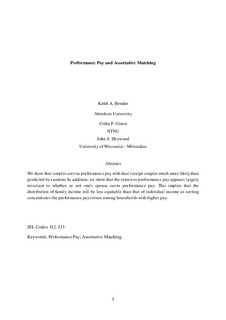| dc.contributor.author | Bender, Keith | |
| dc.contributor.author | Green, Colin | |
| dc.contributor.author | Heywood, John S. | |
| dc.date.accessioned | 2019-10-28T12:49:15Z | |
| dc.date.available | 2019-10-28T12:49:15Z | |
| dc.date.created | 2019-10-25T08:45:50Z | |
| dc.date.issued | 2019 | |
| dc.identifier.issn | 0036-9292 | |
| dc.identifier.uri | http://hdl.handle.net/11250/2624911 | |
| dc.description.abstract | We show that couples sort on performance pay with dual receipt couples much more likely than predicted by random. In addition, we show that the return to performance pay appears largely invariant to whether one's spouse earns performance pay. The major exception is that among the college educated, the return to performance pay is larger for women when their spouse also receives performance pay. Thus, dual receipt households concentrate the returns to performance pay hinting that performance pay may influence the distribution of household income. | nb_NO |
| dc.language.iso | eng | nb_NO |
| dc.publisher | Wiley | nb_NO |
| dc.title | Performance Pay and Assortative Matching | nb_NO |
| dc.type | Journal article | nb_NO |
| dc.type | Peer reviewed | nb_NO |
| dc.description.version | acceptedVersion | nb_NO |
| dc.source.journal | Scottish Journal of Political Economy | nb_NO |
| dc.identifier.doi | doi.org/10.1111/sjpe.12232 | |
| dc.identifier.cristin | 1740443 | |
| dc.description.localcode | Locked until 25.9.2020 due to copyright restrictions. This is the peer reviewed version of an article, which has been published in final form at [https://doi.org/10.1111/sjpe.12232]. This article may be used for non-commercial purposes in accordance with Wiley Terms and Conditions for Self-Archiving. | nb_NO |
| cristin.unitcode | 194,60,20,0 | |
| cristin.unitname | Institutt for samfunnsøkonomi | |
| cristin.ispublished | false | |
| cristin.fulltext | postprint | |
| cristin.qualitycode | 1 | |
